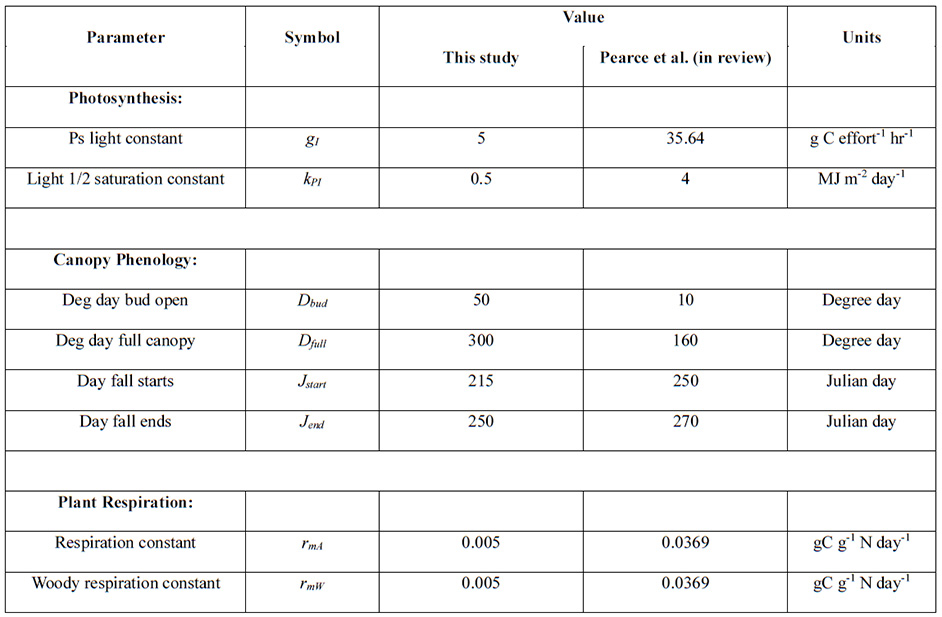
Ecological Archives A025-101-A1
Yueyang Jiang, Edward S. Rastetter, Adrian V. Rocha, Andrea R. Pearce, Bonnie L. Kwiatkowski, and Gaius R. Shaver. 2015. Modeling carbon–nutrient interactions during the early recovery of tundra after fire. Ecological Applications 25:1640–1652. http://dx.doi.org/10.1890/14-1921.1
Appendix A. Changes to multiple element limitation (MEL) model parameters and field measurement and model comparison.
Table A1. Parameters different from Pearce et al. (in review).
Table A2. Comparison of model results between simulations using parameterizations in Pearce et al. (in review) and the modified parameterization in this study. The harvest data was derived from Bret-Harte et al. (2013).
|
This study |
Pearce et al. (in review) |
Harvest data |
NEP fitting: |
Severe burn: Slope: 0.96; R2: 0.71; RMSE: 0.72. Moderate burn: Slope: 0.93; R2: 0.45; RMSE: 0.86. Unburned site: Slope: 0.86; R2: 0.29; RMSE: 0.68. |
Severe burn: Slope: 0.75; R2: 0.61; RMSE: 0.84. Moderate burn: Slope: 0.71; R2: 0.19; RMSE: 1.04. Unburned site: Slope: 0.65; R2: 0.12; RMSE: 0.76. |
|
Above-ground NPP* (g C/m²/year) |
Severe burn: 139 Moderate burn: 151 Unburned site: 138 |
Severe burn: 159 Moderate burn: 171 Unburned site: 146 |
Severe burn: 76 ± 28 Moderate burn: 121 ± 33 Unburned site: 96 ± 19 |
Biomass (g DW/m²/year) |
Severe burn: Total biomass (720); Leaf (117); Wood (415); Root (189). Moderate burn: Total biomass (792); Leaf (120); Wood (466); Root (206). Unburned site: Total biomass (1392); Leaf (119); Wood (948); Root (322). |
Severe burn: Total biomass (745); Leaf (145); Wood (418); Root (183). Moderate burn: Total biomass (780); Leaf (149); Wood (438); Root (193). Unburned site: Total biomass (1256); Leaf (149); Wood (826); Root (281). |
Severe burn: Total biomass (543 ± 6); Leaf (227 ± 96); Wood (228 ± 35); Root (88 ± 54). Moderate burn: Total biomass (927 ± 252); Leaf (221 ± 88); Wood (424 ± 53); Root (282 ± 112). Unburned site: Total biomass (1553 ± 286); Leaf (426 ± 7); Wood (786 ± 240); Root (340 ± 39). |
Soil inorganic N (g N/m²) |
Severe burn: 5.30 Moderate burn: 1.33 Unburned site: 2.83 |
Severe burn: 7.38 Moderate burn: 3.57 Unburned site: 0.91 |
Severe burn: 5.72 ± 4.04 Moderate burn: 1.17 ± 0.03 Unburned site: 2.58 ± 1.50 |
Soil DON pool (g N/m²) |
Severe burn: 3.97 Moderate burn: 4.55 Unburned site: 2.36 |
Severe burn: 2.82 Moderate burn: 3.45 Unburned site: 4.02 |
Severe burn: 5.84 ± 0.19 Moderate burn: 4.89 ± 0.62 Unburned site: 5.60 ± 0.40 |
* The simulated above ground NPP (ANPP) was calculated by multiplying the total NPP (TNPP) with a proportion of 0.61, based on the ratio of ANPP:TNPP of tussock tundra in Shaver (2013).
Literature cited
Bret-Harte, M. S., M. C. Mack, G. R. Shaver, D. C. Huebner, M. Johnston, C. A. Mojica, M. C. Pizano, and J. A. Reiskind. 2013. The response of Arctic vegetation and soils following an unusually severe tundra fire. Philosophical Transactions of the Royal Society B: Biological Sciences 368(1624).
Pearce, A. R., E. B. Rastetter, W. B. Bowden, M. C. Mack, Y. Jiang, B. L. Kwiatkowski. In press. Recovery of arctic tundra from thermal erosion disturbance is constrained by nutrient accumulation: a modeling analysis. Ecological Applications.
Shaver, G. R. 2013. NPP Tundra: Toolik Lake, Alaska, 1982, R1. Data set. Available on-line [http://daac.ornl.gov] from Oak Ridge National Laboratory Distributed Active Archive Center, Oak Ridge, Tennessee, USA. doi:10.3334/ORNLDAAC/581.